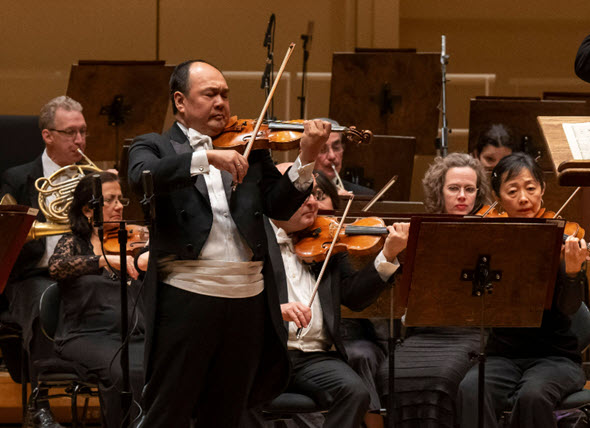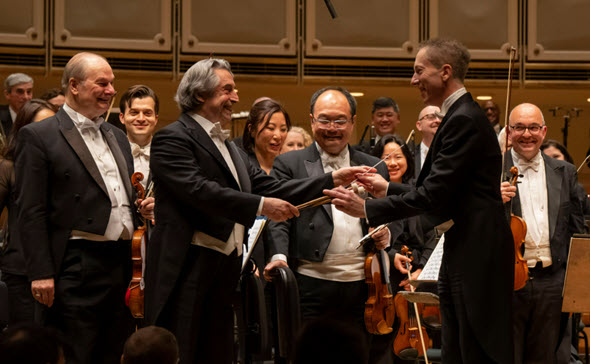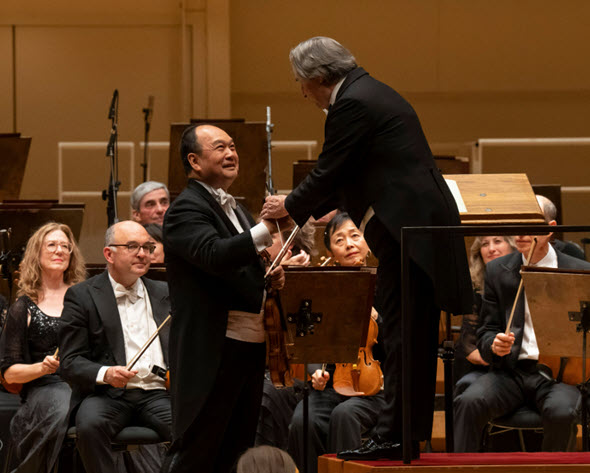As Muti era spins toward close, he spotlights musicians who helped create an epic splendor
Commentary: In two programs, music director Riccardo Muti featured Chicago Symphony principals and every stellar section.
By Lawrence B. Johnson
Two consecutive weeks of concerts at Orchestra Hall, marking Riccardo Muti’s penultimate stint as music director before what figures to be quite a grand finale in June, amounted to something of an extended house party – just the man and his band in showcase concerts that spoke volumes about the mettle of the Chicago Symphony Orchestra and the 13 seasons of their creative togetherness.
Muti makes his final appearances as music director in concerts June 15-17, pairing Lalo Schifrin’s Tuba Concerto played by CSO principal Gene Pokorny and Schubert’s “Great” C major Symphony, and June 23-25 with perhaps the monument of all orchestral monuments, Beethoven’s Missa Solemnis. One has every reason to expect both weeks to be etched in permanent memory. Yet the two weeks just concluded were likewise special as thrilling exhibitions of house music CSO-style.
The more recent was the more overtly spectacular – William Kraft’s Timpani Concerto No. 1 with CSO principal David Herbert and Respighi’s Technicolor tone poem “Pines of Rome” with, well, just everybody. Hardly a throwaway as the curtain-raiser was the 16-year-old Mozart’s Divertimento in F for strings, K. 138, which a small group of CSO virtuosi imbued with sparkling buoyancy and the inimitable panache of an adolescent like no other.
Then Muti’s principal timpanist strode onto the stage to a ripping ovation that would prove to be a mere disturbance in the Force compared with what followed his wizardly performance of Kraft’s concerto. After acknowledging the welcoming accolades, Herbert hiked upstage to his circled drums to commence a tour de force that was as visually Olympian as it was musically staggering.
Beyond the usual assortment of mallets Herbert utilizes week in and week out, the Kraft concerto had him donning finger sleeves at the beginning to produce a singular soft swoosh in rapid taps to set the work in motion. As the concerto progressed, so did the intricacy and interconnection between the many-faceted drumming and the colorful orchestral voices that answered or seconded or challenged the timpani’s lead.
The concerto’s breath-gentle slow movement, a sort of intermezzo, put one in mind of the middle movement of Beethoven’s Fourth Piano Concerto – a quiet, shadowy, ruminative bridge linking outer narrative episodes. But in Herbert’s hands, it became a mesmerizing display of drumming sotto voce. I couldn’t help thinking of great jazz drummers like Joe Morello and Art Blakey.
Stravinsky once observed that he never closed his eyes during a concert because his mind would wander. If you closed your eyes during Herbert’s burn through the finale of this concerto, you would miss half the fun. After the performance, I heard someone exclaim that Herbert had played the piece without a score. My thought was: How in the world could he have been reading music and whipping around among those drum heads at the same time? The speed and precision of Herbert’s hands and mallets through the rocketing finale had to be seen, not to be believed but to be fully appreciated. A recording could never match the live experience.
The ovation that followed was something to behold: a sustained cataclysmic roar. On the spot, a gleeful Muti proposed an exchange of sticks, his baton for the pair of mallets Herbert still held. Maybe the conductor suspected there was magic in those speedy, sure-shot drum sticks.
Muti capped the evening with Respighi’s “Pines of Rome,” a grand canvas for a very large ensemble. Its four tableaux, each depicting a famous aspect of Roman culture or history, tap into every corner of an orchestra’s collective virtuosity, from the most fragile woodwind tracings and gossamer string playing to the final house-shaking crescendo for brass (and everybody else) evocative of Roman legions marching up the Appian Way. This last long proclamation swells to a sound as mighty – read: loud – as anything written for orchestra. Despite its rising intensity, the music under Muti’s baton never blared: It was as gorgeous as it was daunting.
The Mozart divertimento that opened this concert felt like a continuation of the previous week’s program, which paired Mozart’s Violin Concerto No. 4, featuring concertmaster Robert Chen, and the Gran Partita for 12 winds and string bass. Chen delivered a burnished performance of consummate technical mastery, stylistic awareness and sheer expressive finesse. This was Mozart at once sunny and elegant and wise, and Muti’s scaled-back ensemble provided eloquent support for their No. 1 colleague.
The concert’s second half essentially amounted to an exquisite showcase for the CSO winds – Mozart’s Serenade No. 10 in B-flat for winds and string bass, K. 361, aptly subtitled Gran Partita. This prodigious essay in seven movements is grand, indeed, a work whose astonishing invention is matched by its transparent intimacy. With the musicians arranged in a semicircle, Muti led from a chair, without a baton and with minimal gestures at that. It was chamber music with the conductor as deferential coordinator. To call the playing radiant would be an understatement, albeit fitting in the sense that everything about this masterly music-making bespoke subtlety.
Abetted by a handful of winds, the CSO strings opened the program with an eye-opening discovery, the brilliant overture to Domenico Cimarosa’s 1792 opera “The Secret Marriage.” Muti presided over a scintillating account, a harbinger of two splendid programs that reflected an era now sweeping toward its final flourishes.






